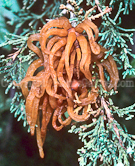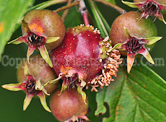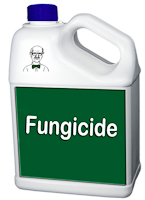|
 |
|
 |
|
 |
|
 |
 |
 There are several different leaf rust
diseases of landscape trees and shrubs. Most of them
require an alternate host during the life cycle. Part of
the year, the infection is on the ornamental tree or
shrub while the rest of the year it grows on another
plant of a different species. There are several different leaf rust
diseases of landscape trees and shrubs. Most of them
require an alternate host during the life cycle. Part of
the year, the infection is on the ornamental tree or
shrub while the rest of the year it grows on another
plant of a different species.
The spores of these
fungal diseases are encouraged by warm, moist weather
and spread between the hosts in the wind or by splashing
water.
|
 |
|
 |
 |
 As the name implies, plants infested
with a rust disease have some sort of "rusty" colored
spots or growths (pustules) on their foliage. The leaves
may also be mottled yellow or brown and twisted or
distorted. Although it is often a chronic disease,
plants may be stunted due to the loss of
chlorophyll in
the leaves. Some rust fungi produce spores in spots or
patches, while others develop into hornlike structures. As the name implies, plants infested
with a rust disease have some sort of "rusty" colored
spots or growths (pustules) on their foliage. The leaves
may also be mottled yellow or brown and twisted or
distorted. Although it is often a chronic disease,
plants may be stunted due to the loss of
chlorophyll in
the leaves. Some rust fungi produce spores in spots or
patches, while others develop into hornlike structures.
|
 |
 |
 |
 The best way to prevent
rust diseases is to grow resistant plants and keep them
as stress free as possible. Rust disease in lawns is
greatly encouraged by sites that are low in nutrients.
For rusts that have alternate hosts, eliminating one of
the two host species may help. Unfortunately, for the
typical home garden, this is generally not effective. The best way to prevent
rust diseases is to grow resistant plants and keep them
as stress free as possible. Rust disease in lawns is
greatly encouraged by sites that are low in nutrients.
For rusts that have alternate hosts, eliminating one of
the two host species may help. Unfortunately, for the
typical home garden, this is generally not effective.
|
 |
 |
 |

Most rust
disease of ornamental plants are primarily aesthetic and
do not require treatment. However, several
fungicides
are labeled for use on these plants to prevent the
infection. Removal of the alternate host from the area
has been tried but is usually not effective.
|
|
 |
|
Note: We
have provided some general information and
observations on this topic aimed at the home
gardener. Before you take
any serious action in your landscape, check
with your state's land grant university's
Cooperative
Extension
Service for the most current,
appropriate, localized recommendations. |
|
 |
 |
 |
Perhaps the most common of these diseases would include
Cedar-Apple Rust.
|
 |



